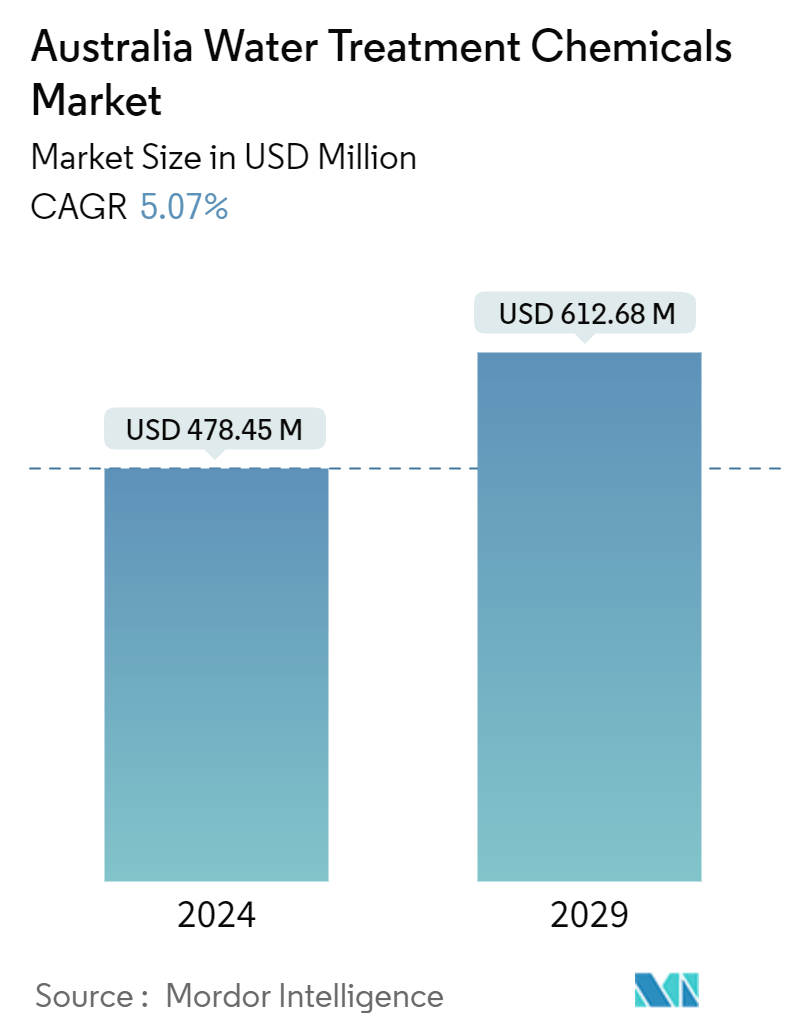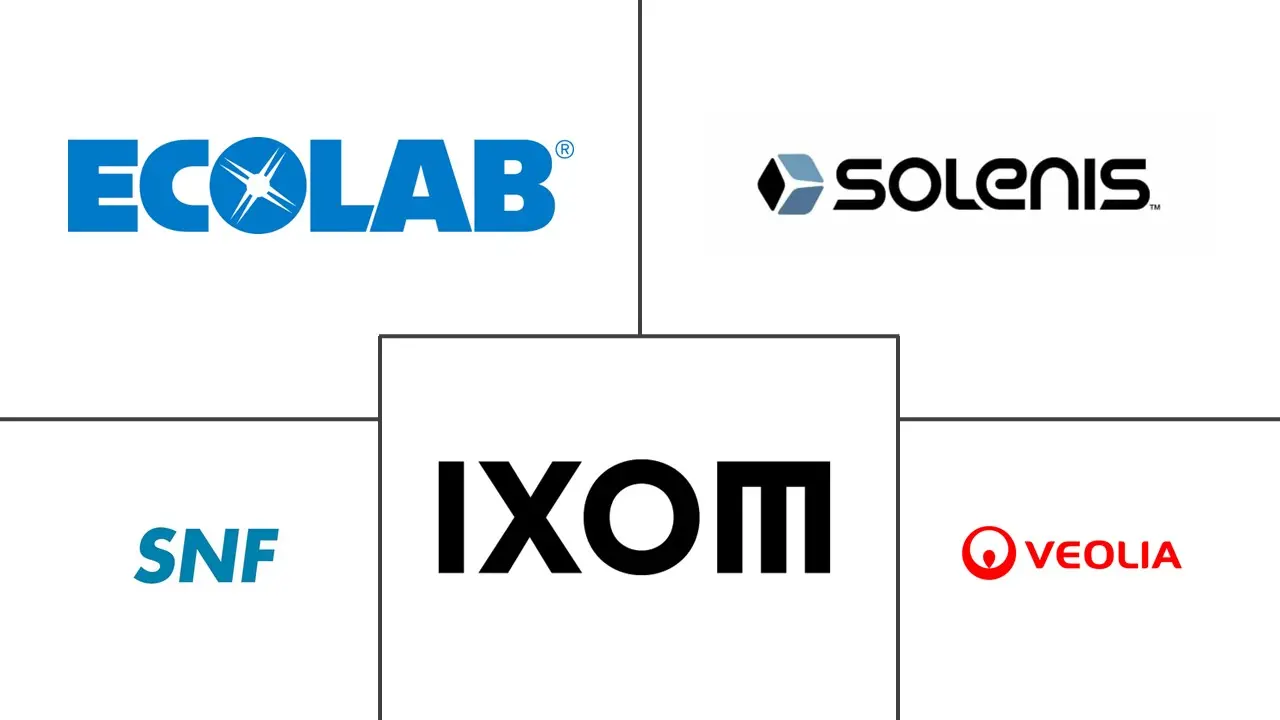Market Size of Australia Water Treatment Chemicals Industry

| Study Period | 2019 - 2029 |
| Base Year For Estimation | 2023 |
| Market Size (2024) | USD 478.45 Million |
| Market Size (2029) | USD 612.68 Million |
| CAGR (2024 - 2029) | 5.07 % |
| Market Concentration | High |
Major Players
*Disclaimer: Major Players sorted in no particular order |
Australia Water Treatment Chemicals Market Analysis
The Australia Water Treatment Chemicals Market size is estimated at USD 478.45 million in 2024, and is expected to reach USD 612.68 million by 2029, growing at a CAGR of 5.07% during the forecast period (2024-2029).
- Rising ground and surface water pollution, growing demand from power and industrial applications, and government intervention in reliable wastewater management are expected to boost the water treatment chemicals market in Australia.
- However, the hazardous nature of hydrazine and emerging alternatives to water treatment chemicals are expected to hinder the market's growth.
- Nevertheless, the shifting focus toward green chemicals is likely to create lucrative growth opportunities for the market studied.
- The municipal segment is expected to be the largest end-user industry by registering rapid growth over the forecast period.
Australia Water Treatment Chemicals Industry Segmentation
Water treatment is a process that extracts or reduces the level of pollutants and undesirable components from water to make it suitable for use. The chemicals used in this method are referred to as water treatment chemicals. Algicide, chlorine, and chlorine dioxide are some examples of water treatment chemicals.
The water treatment chemicals market is segmented by product type and end-user industry. By product type, the market is segmented into biocides and disinfectants, coagulants and flocculants, corrosion and scale inhibitors, defoamers and defoaming agents, pH conditioners/adjusters, and other product types. By end-user industry, the market is segmented into power generation, oil and gas, chemical manufacturing, mining and mineral processing, municipal, food and beverage, pulp and paper, and other end-user industries. For each segment, the market sizing and forecasts have been done on the basis of value (USD).
| By Product Type | |
| Biocides and Disinfectants | |
| Coagulants and Flocculants | |
| Corrosion and Scale Inhibitors | |
| Defoamers and Defoaming Agents | |
| pH Conditioners/Adjusters | |
| Other Product Types |
| By End-user Industry | |
| Power Generation | |
| Oil and Gas | |
| Chemical Manufacturing | |
| Mining and Mineral Processing | |
| Municipal | |
| Food and Beverage | |
| Pulp and Paper | |
| Other End-user Industries |
Australia Water Treatment Chemicals Market Size Summary
The Australian water treatment chemicals market is poised for growth, driven by increasing pollution of ground and surface water, rising demand from power and industrial sectors, and government initiatives aimed at effective wastewater management. The market, which faced setbacks due to the COVID-19 pandemic, has shown signs of recovery and is expected to expand significantly in the coming years. The scarcity of potable water, coupled with a growing population, underscores the critical need for water treatment solutions. The municipal sector plays a pivotal role in this market, with substantial investments in water and wastewater treatment infrastructure. The Australian government's National Water Grid Fund and other budget allocations highlight the commitment to enhancing water infrastructure, further fueling market growth.
Despite challenges such as the hazardous nature of certain chemicals and the emergence of alternatives, the market is likely to benefit from a shift towards green chemicals, presenting new growth opportunities. Corrosion and scale inhibitors are essential components in maintaining the efficiency of water treatment systems, particularly in the oil and gas and petrochemical industries. The fragmented nature of the market sees major players like Veolia, Ecolab, Solenis, SNF, and Ixom actively participating in technological advancements and partnerships to strengthen their market positions. Innovations such as Kemira Oyj's collaboration with Veolia to recover valuable resources from sewage sludge exemplify the ongoing efforts to address environmental concerns and enhance the sustainability of water treatment processes.
Australia Water Treatment Chemicals Market Size - Table of Contents
-
1. MARKET DYNAMICS
-
1.1 Market Drivers
-
1.1.1 Rising Groundwater and Surface Water Pollution
-
1.1.2 Growing Demand From Power and Industrial Applications
-
1.1.3 Increasing Government Intervention in Reliable Wastewater Management
-
-
1.2 Market Restraints
-
1.2.1 Hazardous Nature of Hydrazine
-
1.2.2 Emerging Alternatives to Water Treatment Chemicals
-
-
1.3 Industry Value Chain Analysis
-
1.4 Porter's Five Forces Analysis
-
1.4.1 Bargaining Power of Suppliers
-
1.4.2 Bargaining Power of Buyers
-
1.4.3 Threat of New Entrants
-
1.4.4 Threat of Substitute Products and Services
-
1.4.5 Degree of Competition
-
-
-
2. MARKET SEGMENTATION
-
2.1 By Product Type
-
2.1.1 Biocides and Disinfectants
-
2.1.2 Coagulants and Flocculants
-
2.1.3 Corrosion and Scale Inhibitors
-
2.1.4 Defoamers and Defoaming Agents
-
2.1.5 pH Conditioners/Adjusters
-
2.1.6 Other Product Types
-
-
2.2 By End-user Industry
-
2.2.1 Power Generation
-
2.2.2 Oil and Gas
-
2.2.3 Chemical Manufacturing
-
2.2.4 Mining and Mineral Processing
-
2.2.5 Municipal
-
2.2.6 Food and Beverage
-
2.2.7 Pulp and Paper
-
2.2.8 Other End-user Industries
-
-
Australia Water Treatment Chemicals Market Size FAQs
How big is the Australia Water Treatment Chemicals Market?
The Australia Water Treatment Chemicals Market size is expected to reach USD 478.45 million in 2024 and grow at a CAGR of 5.07% to reach USD 612.68 million by 2029.
What is the current Australia Water Treatment Chemicals Market size?
In 2024, the Australia Water Treatment Chemicals Market size is expected to reach USD 478.45 million.

